 One of the most significant and exciting changes introduced in the Strengthening Career and Technical Education for the 21st Century Act (Perkins V) is the new comprehensive local needs assessment (CLNA). The purpose of the CLNA is to support data-driven decisionmaking and more closely align planning, spending and accountability activities under Perkins V. The results of the local needs assessment must form the foundation of the local application and drive local spending decisions.
One of the most significant and exciting changes introduced in the Strengthening Career and Technical Education for the 21st Century Act (Perkins V) is the new comprehensive local needs assessment (CLNA). The purpose of the CLNA is to support data-driven decisionmaking and more closely align planning, spending and accountability activities under Perkins V. The results of the local needs assessment must form the foundation of the local application and drive local spending decisions.
The CLNA presents an incredible opportunity for states and locals to bring focus and purpose to their Career Technical Education (CTE) offerings and programs. At the same time, it will take an incredible lift from state and local leaders to truly maximize the CLNA. To support states in this undertaking, Advance CTE convened a Shared Solutions Workgroup, with support from the Association of Career and Technical Education and funded by the Bill & Melinda Gates Foundation. The Workgroup – comprised of state and national leaders – is charged with informing and contributing to the development of resources and tools for the benefit of all states, as they guide local recipients in conducting rigorous CLNA that drive program quality, equity and access.
Today, Advance CTE is releasing the first two deliverables from this Workgroup: Driving Quality & Equity in CTE: A State Guide to Developing the Perkins V Comprehensive Local Needs Assessment Template and a State Needs Assessment Crosswalk.
The State Guide helps states identify the major decision points that will impact the design, development and implementation of their CLNA and related local application. It provides guidance around key decisions such as: how should states structure the template? Who is required to complete the comprehensive local needs assessment? What evidence will be required? How will the CLNA connect with the local application and local uses of Perkins V funds? The State Guide also provides a bank of questions to draw from to help states create a template that elevates and addresses state and local priorities.
The State Needs Assessment Crosswalk is designed to support state-level discussions about and the coordination of state- and federally required needs assessments, such as the required under Perkins V, the Every Student Succeeds Act and the Workforce Innovation and Opportunity Act. The crosswalk tool is available in both in Excel and Google spreadsheet.
There will be a second set of deliverables from the CLNA Shared Solutions Workgroup released later this summer. All of Advance CTE’s and partners’ Perkins V resources can be found here.
Kate Kreamer, Deputy Executive Director


 Throughout history, and continuing today, learners of color, low-income learners, female learners and learners with disabilities have been historically tracked into terminal vocational programs leading to jobs with uncertain promise of economic growth and prosperity. Today, the quality of Career Technical Education (CTE) has vastly improved, making it a preferred path for many secondary and postsecondary learners. Yet even today, many learners do not have access to high-quality programs of study in their communities. To help state leaders recognize historical barriers and adopt promising solutions to close equity gaps in CTE, Advance CTE launched a series of policy briefs titled
Throughout history, and continuing today, learners of color, low-income learners, female learners and learners with disabilities have been historically tracked into terminal vocational programs leading to jobs with uncertain promise of economic growth and prosperity. Today, the quality of Career Technical Education (CTE) has vastly improved, making it a preferred path for many secondary and postsecondary learners. Yet even today, many learners do not have access to high-quality programs of study in their communities. To help state leaders recognize historical barriers and adopt promising solutions to close equity gaps in CTE, Advance CTE launched a series of policy briefs titled 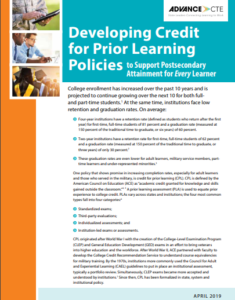 College enrollment has increased over the past 10 years and is projected to continue growing over the next 10 for both full- and part-time students. At the same time, institutions face low retention and graduation rates. One policy that shows promise in increasing completion rates, especially for adult learners and those who served in the military, is credit for prior learning (CPL). CPL practices have been found increase access to and the affordability of postsecondary opportunities for a variety of learners — particularly adults and members of the military.
College enrollment has increased over the past 10 years and is projected to continue growing over the next 10 for both full- and part-time students. At the same time, institutions face low retention and graduation rates. One policy that shows promise in increasing completion rates, especially for adult learners and those who served in the military, is credit for prior learning (CPL). CPL practices have been found increase access to and the affordability of postsecondary opportunities for a variety of learners — particularly adults and members of the military. 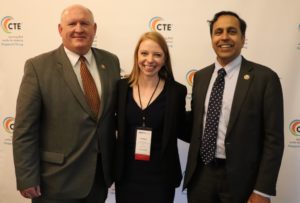 115th Congress. Fast forward one year and the reauthorization – the Strengthening Career and Technical Education for the 21st Century Act (Perkins V) – has been on the books for more than eight months! However, we certainly wouldn’t be in this position without the leadership of the law’s co-sponsors in the U.S. House of Representatives, Congressmen Raja Krishnamoorthi (D-IL) and Glenn ‘GT’ Thompson (R-PA). Advance CTE was thrilled to have these two dedicated CTE champions join us at this year’s Spring Meeting and I was honored to have the privilege of moderating the conversation.
115th Congress. Fast forward one year and the reauthorization – the Strengthening Career and Technical Education for the 21st Century Act (Perkins V) – has been on the books for more than eight months! However, we certainly wouldn’t be in this position without the leadership of the law’s co-sponsors in the U.S. House of Representatives, Congressmen Raja Krishnamoorthi (D-IL) and Glenn ‘GT’ Thompson (R-PA). Advance CTE was thrilled to have these two dedicated CTE champions join us at this year’s Spring Meeting and I was honored to have the privilege of moderating the conversation. 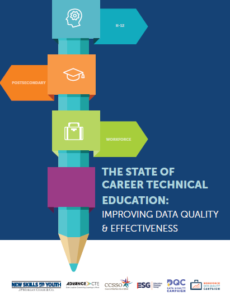 How many girls of color earned an industry-recognized credential in Information Technology last year? What types of work-based learning experiences lead to the best wage outcomes for learners from low-income families? How many graduates from Career Technical Education (CTE) programs in advanced manufacturing go on to work in their field of study?
How many girls of color earned an industry-recognized credential in Information Technology last year? What types of work-based learning experiences lead to the best wage outcomes for learners from low-income families? How many graduates from Career Technical Education (CTE) programs in advanced manufacturing go on to work in their field of study? Ensuring learners are prepared with the skills and experiences they need for high-wage, high-skill employment in in-demand occupations is a shared responsibility among secondary education, postsecondary education and the workforce sector. Yet too many states continue to use disparate data systems for collecting, validating and accessing learner-level data. Using disparate systems not only increases the data collection burden for local leaders but also threatens the quality of the data and the ability of state leaders to use their data effectively.
Ensuring learners are prepared with the skills and experiences they need for high-wage, high-skill employment in in-demand occupations is a shared responsibility among secondary education, postsecondary education and the workforce sector. Yet too many states continue to use disparate data systems for collecting, validating and accessing learner-level data. Using disparate systems not only increases the data collection burden for local leaders but also threatens the quality of the data and the ability of state leaders to use their data effectively. The Met, a work-based learning focused technical center in Providence, Rhode Island, serves about 800 students across the state. It is also one of eight recipients of
The Met, a work-based learning focused technical center in Providence, Rhode Island, serves about 800 students across the state. It is also one of eight recipients of 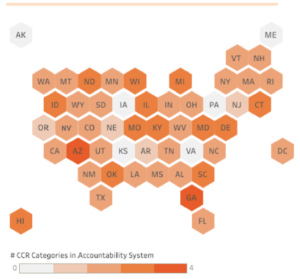 In a strong signal of support for Career Technical Education (CTE) and career readiness in high school, 40 states are now measuring career readiness in their state or federal high school accountability systems. Fewer than half as many – 17 – were measuring career readiness just five years ago.
In a strong signal of support for Career Technical Education (CTE) and career readiness in high school, 40 states are now measuring career readiness in their state or federal high school accountability systems. Fewer than half as many – 17 – were measuring career readiness just five years ago.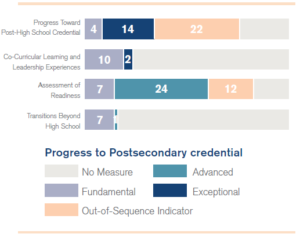 Another commonly used measure is Progress Toward Post-High School Credential. Seventeen states and the District of Columbia include measures aligned with the Destination Known recommendations, and another 22 states include out of sequence indicators. A number of states include either pathway completion or dual enrollment coursework in their accountability plans without requiring that experience to be accompanied by the completion of a state-defined college- and career-ready course of study, which is the Fundamental measurement in this category.
Another commonly used measure is Progress Toward Post-High School Credential. Seventeen states and the District of Columbia include measures aligned with the Destination Known recommendations, and another 22 states include out of sequence indicators. A number of states include either pathway completion or dual enrollment coursework in their accountability plans without requiring that experience to be accompanied by the completion of a state-defined college- and career-ready course of study, which is the Fundamental measurement in this category.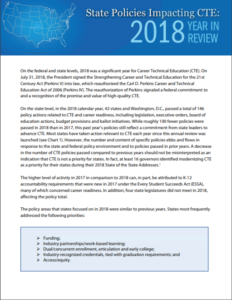 2018 was a significant year for Career Technical Education (CTE) at the federal and state levels. On July 31, 2018, the President signed the Strengthening Career and Technical Education for the 21st Century Act (Perkins V) into law, which reauthorized the Carl D. Perkins Career and Technical Education Act of 2006 (Perkins IV). The reauthorization of Perkins signaled a federal commitment to and a recognition of the promise and value of high-quality CTE. Additionally, at the state level 42 states and Washington, D.C., passed a total of 146 policy actions related to CTE and career readiness, reflecting a commitment from state leaders to advance CTE.
2018 was a significant year for Career Technical Education (CTE) at the federal and state levels. On July 31, 2018, the President signed the Strengthening Career and Technical Education for the 21st Century Act (Perkins V) into law, which reauthorized the Carl D. Perkins Career and Technical Education Act of 2006 (Perkins IV). The reauthorization of Perkins signaled a federal commitment to and a recognition of the promise and value of high-quality CTE. Additionally, at the state level 42 states and Washington, D.C., passed a total of 146 policy actions related to CTE and career readiness, reflecting a commitment from state leaders to advance CTE.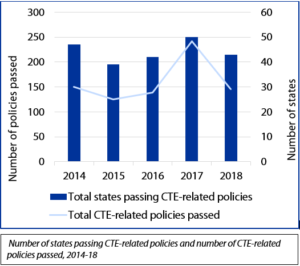 While roughly one hundred fewer policies were passed in 2018 than in 2017, this past year’s policies still reflect a commitment from state leaders to advance CTE. A decrease in the number of CTE policies passed compared to previous years should not be misinterpreted as an indication that CTE is not a priority for states. In fact,
While roughly one hundred fewer policies were passed in 2018 than in 2017, this past year’s policies still reflect a commitment from state leaders to advance CTE. A decrease in the number of CTE policies passed compared to previous years should not be misinterpreted as an indication that CTE is not a priority for states. In fact,  Middle school Career Technical Education (CTE) has the power to expose students to college and career options and equip them with the transferable skills they need to plan for and succeed in high school and beyond. In recent years, a number of states have invested resources and supports to expand CTE and career exploration opportunities in middle schools, a trend that is likely to continue with the recent passage of the Strengthening Career Technical Education for the 21st Century Act (Perkins V), which now allows states to use Perkins funding to support CTE as early as the fifth grade.
Middle school Career Technical Education (CTE) has the power to expose students to college and career options and equip them with the transferable skills they need to plan for and succeed in high school and beyond. In recent years, a number of states have invested resources and supports to expand CTE and career exploration opportunities in middle schools, a trend that is likely to continue with the recent passage of the Strengthening Career Technical Education for the 21st Century Act (Perkins V), which now allows states to use Perkins funding to support CTE as early as the fifth grade.